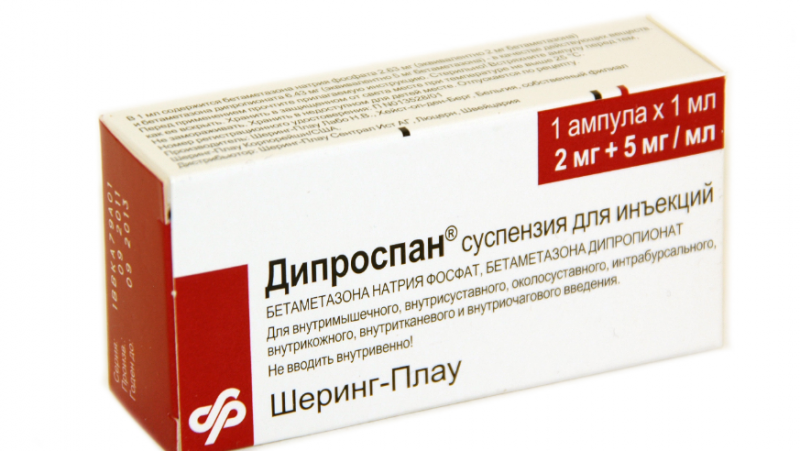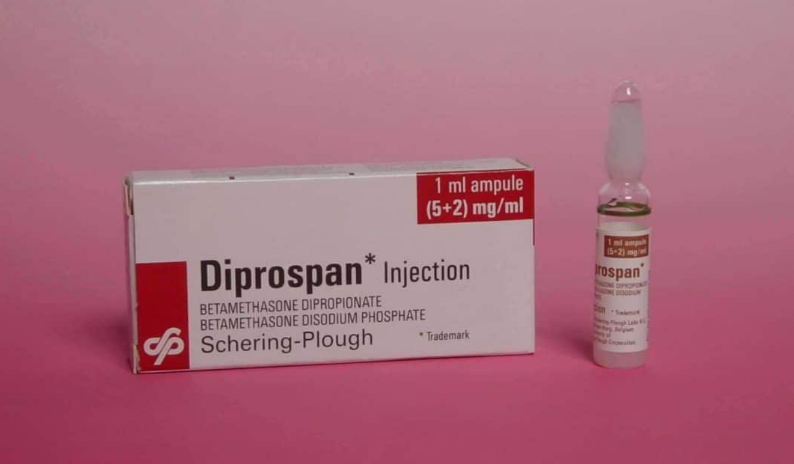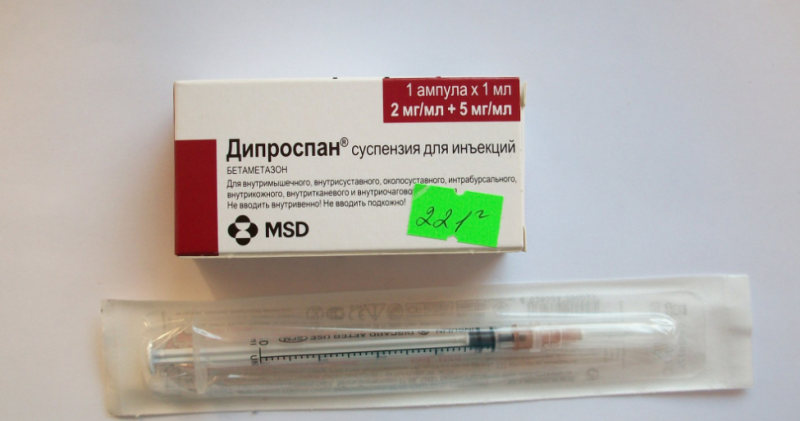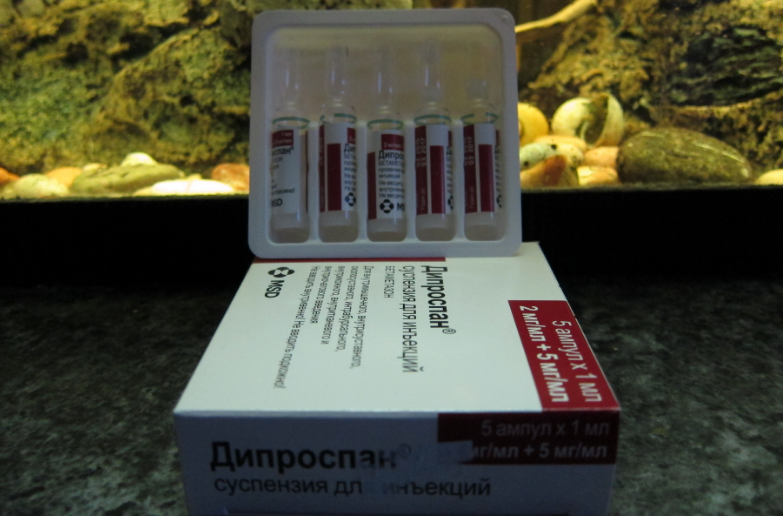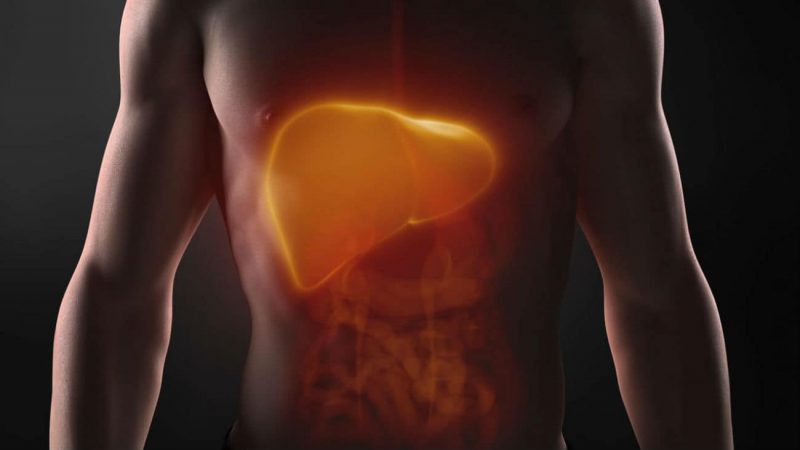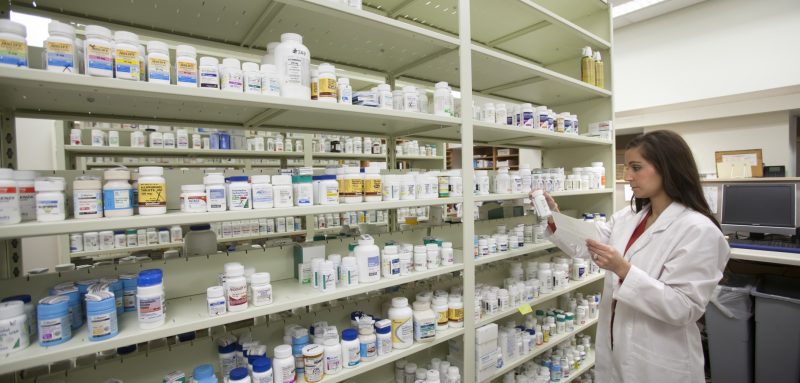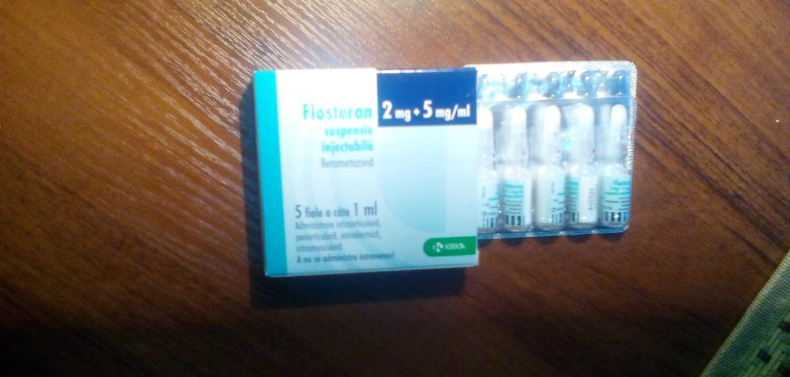"Diprospan" refers to a group of hormonal drugs, the spectrum of exposure of which is based on the work of the substance betamethasone. Designed to relieve inflammation and swelling, eliminates allergic reactions, effective as an autoimmune drug.
Material Content:
- 1 Release form, composition and packaging
- 2 Pharmacological action, pharmacodynamics and pharmacokinetics
- 3 What helps Diprospan
- 4 Instructions for use and dosage
- 5 During pregnancy and breastfeeding
- 6 Drug interaction
- 7 Diprospan Compatibility with Alcohol
- 8 Contraindications, side effects and overdose
- 9 Analogs
- 10 Which is better, floosterone or diprospan
Release form, composition and packaging
Medicines in pharmacies can be purchased in one of two forms offered by the manufacturer: a solution or suspension for injection. The medicine is placed in a cardboard box, where 1 to 5 units of 1 ml are packed. The suspension is sealed in ampoules and syringes. The solution is sold only in the form of ampoules.
The suspension is a viscous transparent liquid with a white precipitate at the bottom. As a result of agitation, it acquires a pronounced white color.
The solution is a clear, colorless mixture.
The suspension includes betamethasone dipropionate and a number of excipients.
The composition of the solution differs in the form of the active substance. In it, betamethasone is presented in the form of 2 mg of disodium phosphate and 5 mg of dipropionate.
Pharmacological action, pharmacodynamics and pharmacokinetics
In the form of pharmacological effects, “Diprospan” refers to glucocorticosteroids. It has a pronounced ability to inhibit affected and inflamed cells (glucocorticoid activity), which allows you to effectively localize foci of inflammation.
Mineralocorticoid activity is poorly expressed.
Pharmacodynamics is characterized by an intense and variable effect on metabolism, relieves inflammatory processes, reduces the manifestation of allergic reactions, and also has an immunosuppressive effect.
The basic components of the drug are characterized by different pharmacokinetics. So, betamethasone sodium phosphate has fast solubility, which allows you to get the necessary effect on the body in the shortest possible time. The elimination period of the component is 24 hours.
Betamethasone dipropionate has a slow hydrolysis, which accompanies a long absorption period. A similar property of the drug determines the long-term effect of therapy, the substance remains active for 10 days after administration.
The absorption of betamethasone occurs in the cells of the liver and is accompanied by the synthesis of inactive metabolites. The breakdown products of the drug are excreted from the body by the kidneys.
What helps Diprospan
An abstract to the drug contains information from which the medication helps.
"Diprospan" is indicated for the treatment of pathologies caused by microorganisms susceptible to the effects of therapy based on corticosteroids. It is prescribed to adult patients as the main or auxiliary means.
The spectrum of the drug is wide enough:
- pathological conditions of muscle, bone and connective tissue: rheumatoid arthritis, lumbar lumbago, osteoarthritis, foot diseases, anocopy syndrome, ankylosing spondylitis, torticollis, plantar fasciitis, lateral epicondylitis, bursitis, sciatica, ganglion cyst;
- tumor diseases of the circulatory and lymphatic systems: acute leukemia, lymphomas;
- Allergic diseases: hay fever, bronchitis, including bronchial asthma;
- adrenal dysfunction (requires additional intake of mineralocorticoids);
- inflammation of the skin: diffuse neurodermatitis, pemphigus, psoriasis, nummular eczema, herpetic dermatitis, lipodystrophy, autoimmune lupus erythematosus, contact and photodermatitis, neuroallergic dermatosis, cystic acne, urticaria, focal alopeciaderma, lichen skederma, lichen redness, red lichenderma, lichen redness, red lichen dermatitis, lichen redness, red licordermia, red lichen dermatitis, red lichen dermatitis, red lichen dermatitis, lichen redness, redness, sclerosis, redness
- other diseases: periarteritis nodosa, nephritis and nephrotic syndrome, adrenogenital syndrome, ulcerative colitis, inflammation of the mucous membrane of the eye, malabsorption in the intestines, regional ileitis.
Often, doctors prescribe Diprospan injections for allergies when there are atypical reactions to medications or insect bites.
Instructions for use and dosage
Annotation to the drug explains that the only possible use of Diprospan is injection.
Possible methods of parenteral administration:
- intramuscularly;
- intrabursally;
- intraarticular;
- periarticularly;
- interstitial;
- intrafocal;
- intradermally.
It is strictly forbidden to administer the drug intravenously or under the skin.
Experts recommend injecting the drug deep into large muscle tissue in order to avoid tissue atrophy.
The dosage of Diprospana is determined by the doctor during the appointment, based on the severity of the disease and the general health of the patient.
The standard dosage ranges from 1 to 2 ml of the drug:
- in dermatology - 1 ml of suspension;
- pathologies of ENT spheres - 1 ml;
- in severe conditions of the patient - 2 ml;
- with exacerbation of the inflammatory processes of the synovial bag - 1 - 2 ml, after removing the pain, the dosage is reduced.
The intervals between injections are determined by the condition of the patient and the presence of positive dynamics. In its absence, "Diprospan" is canceled and replaced by another drug that has a different exposure algorithm.
In most cases, the use of anesthetics for injections is not required.
If their use is appropriate, then fit:
- 1 - 2% solution of procaine hydrochloride;
- 1 - 2% lidocaine solution.
They should not contain traces of phenol, methyl paraben and other similar components.
Dilution technology: initially, the prescribed dosage of “Diprospan” is taken into the syringe, and then the contents are supplemented with the necessary amount of anesthetic. After the end of the fence, the drugs are shaken a little to facilitate the mixing process.
If there are problems with the joints, the drug is administered directly to them. Such a measure allows you to relieve inflammation and pain, and also returns mobility for up to 1 month. Relief occurs on average 3 hours after an intraarticular injection.
Standard dosage:
- for small joints - 0.25 - 0.5 ml;
- for medium - 0.5 - 1 ml;
- for large - 1 - 2 ml.
In the case of diagnosing a serious dermatological pathology, an intradermal injection in the affected area is prescribed. The recommended dosage is 0.2 ml per cm2 of inflammation. A uniform chipping dose is performed, but the total weekly amount of the drug should not exceed 1 ml. The drug is administered using a tuberculin syringe with a 25-26 gauge needle.
After diagnosing positive dynamics, the cancellation of "Diprospan" is carried out gradually by reducing the dosage. However, patient monitoring continues for at least a year.
During pregnancy and breastfeeding
The use of "Diprospan" while carrying a child is undesirable. But in the presence of a serious risk to maternal health, the use of the drug is justified. In such cases, newborns should undergo an emergency examination to exclude the possible appearance of pathologies in the work of the adrenal glands.
If the medication was started during lactation, then breastfeeding should be stopped urgently and the child should be transferred to artificial mixtures.
Drug interaction
The simultaneous use of a number of medications can reduce the effectiveness of Diprospan due to the acceleration of the metabolism that they cause.
Similar medicines include:
- "Diphenin";
- "Luminal";
- "Rifampicin";
- ephedrine.
Diprospan itself slows down the absorption of somatropin.
The concurrent use of GCS and estrogens is fraught with an overdose, therefore, if necessary, such therapy, the dosage should be adjusted.
The components that make up Diprospan cause accelerated leaching of potassium from the body. Therefore, it is not recommended to combine it with diuretics that remove potassium. For the same reason, do not combine the drug with cardiac glycosides.
The combination with non-steroidal anti-inflammatory drugs is also not desirable, since the risk of developing ulcers and erosion of the gastrointestinal tract increases. A joint administration with anticoagulants worsens blood coagulation.
Diprospan Compatibility with Alcohol
The simultaneous use of the drug with alcohol negatively affects health. It can repeatedly increase the side effects of taking the medicine, as well as cause adrenal dysfunction.
In addition, the combined use of Diprospan and alcohol dramatically increases blood sugar levels, increases the risk of hyperglycemia, and may even trigger a coma.
From the side of the cardiovascular system, a jump in arterial and intraocular pressure and hemorrhage of the uveal tract are observed.
The combination of the drug with alcoholic beverages causes severe allergic reactions up to anaphylaxis.
Contraindications, side effects and overdose
The use of the drug is prohibited for patients prone to allergies to the components of the drug, as well as those who are diagnosed with systemic mycosis. In addition, there are a number of contraindications for intraarticular administration of the drug. This is confirmed infectious arthritis and joint instability.
The use of Diprospan is possible, but only under the strict supervision of specialists in the presence of pathologies:
- cirrhosis of the liver;
- eye diseases of herpetic nature;
- renal failure;
- stomach ulcer and 12 duodenal ulcer;
- myxedema;
- purulent infections;
- osteoporosis;
- NAC;
- Erb-Goldflam disease;
- arterial hypertension.
When taking "Diprospan" possible adverse reactions:
- leaching of potassium and calcium, fluid retention in the body;
- pressure surge, in the presence of a predisposition - heart failure;
- allergic reactions and swelling;
- pancreatitis, erosion, gastrointestinal ulcer, flatulence;
- convulsions, dizziness, swelling of the optic nerve disc, insomnia and psychological disorders;
- inhibition of the musculoskeletal segment;
- epidermal dysfunction (delayed healing, dermatitis, acne, increased risk of developing fungal diseases);
- ophthalmic problems (clouding of the lens, glaucoma);
- steroid diabetes, increased need for insulin;
- menstruation cycle failure;
- Itsenko-Cushing's disease;
- mass gain;
- lipomatosis;
- hyperpigmentation and other atypical manifestations at injection sites.
An overdose of “Diprospan” does not pose a threat to the patient’s life in the absence of diseases that force to limit medication (diabetes, gastrointestinal ulceration, glaucoma).
Analogs
Diprospana analogues are widely represented on the pharmaceutical market. An absolute foreign substitute is Flosteron.
Along with it there are a number of drugs that have an algorithm for influencing the body similar to Diprospan:
- Celeston
- "Hepatophone";
- Betaspan
- Kenalog;
- Prednisolone
- Depot-Medrol;
- "Metipred";
- "Dexamethasone";
- "Loracort."
These drugs have approximately the same effectiveness, but vary significantly in price, depending on the country of manufacture.
Which is better, floosterone or diprospan
The drugs have a similar composition and spectrum of action. However, Diprospan costs a bit more. Some doctors say that “Phlosterone” is more effective than “Kenalog” or “Diprospan”. In favor of the latter, statistics speaks, the vast majority of patients have identified less severe adverse reactions and better digestibility.


